Auditory filter shapes and high-frequency hearing in adults who have impaired speech in noise performance despite clinically normal audiograms
- PMID: 21361443
- PMCID: PMC3070989
- DOI: 10.1121/1.3523476
Auditory filter shapes and high-frequency hearing in adults who have impaired speech in noise performance despite clinically normal audiograms
Abstract
Some individuals complain of hearing difficulties in the presence of background noise even in the absence of clinically significant hearing loss (obscure auditory dysfunction). Previous evidence suggests that these listeners have impaired frequency resolution, but there has been no thorough characterization of auditory filter shapes in this population. Here, the filter shapes of adults (n = 14) who self-reported speech recognition problems in noise and performed poorly on a sentence-in-noise perception test despite having clinically normal audiograms were compared to those of controls (n = 10). The filter shapes were evaluated using a 2-kHz probe with a fixed level of 30, 40, or 50 dB sound pressure level (SPL) and notched-noise simultaneous maskers that were varied in level to determine the masker level necessary to just mask the probe. The filters of the impaired group were significantly wider than those of controls at all probe levels owing to an unusual broadening of the upper slope of the filter. In addition, absolute thresholds were statistically indistinguishable between the groups at the standard audiometric frequencies, but were elevated in the impaired listeners at higher frequencies. These results strengthen the idea that this population has a variety of hearing deficits that go undetected by standard audiometry.
Figures
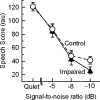
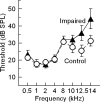
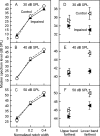
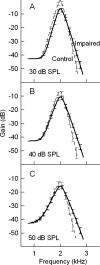

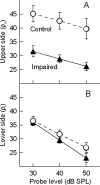
References
-
- Bellis, T. J. (2003). “Comprehensive central auditory assessment,” in Assessment and Management of Central Auditory Processing Disorders in the Educational Setting: From Science to Practice, 2nd ed. (Thomson Learning, Clifton Park, NY: ), pp. 240–280.
-
- Bench, J., and Bamford, J. (Ed.). (1979). Speech-Hearing Tests and the Spoken—Language of Hearing—impaired Children (Academic Press, London: ).
Publication types
MeSH terms
LinkOut - more resources
Full Text Sources
Other Literature Sources
Medical
Miscellaneous

